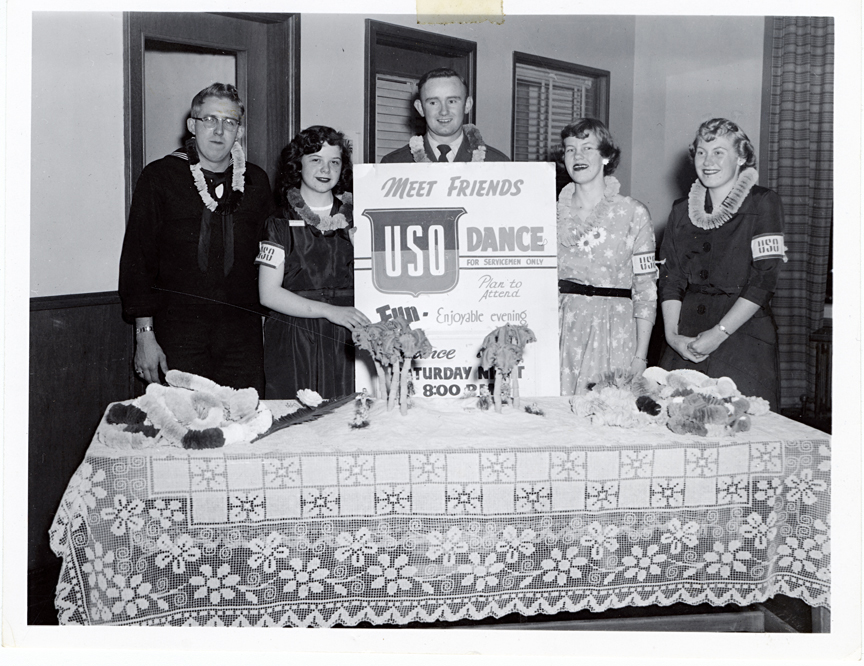- Catalog No. —
- ba018633
- Date —
- April 25th, 1953
- Era —
- 1950-1980 (New Economy, Civil Rights, and Environmentalism)
- Themes —
- Black History, Government, Law, and Politics, Sports and Recreation
- Credits —
- United Services Organizations photographs collection, Org. Lot 91, Oregon Historical Society Research Library
- Regions —
- Portland Metropolitan
- Author —
- Unknown
USO Dance
This photograph, taken during the Korean War, shows two off-duty servicemen and three USO volunteers, donned with leis, at a reception table for an USO-sponsored dance. Men and women stand around a poster advertisement for the event, which promised attendees - exclusively servicemen and USO volunteers, mostly female - that they would "meet friends" and have a "fun, enjoyable evening."
The United Services Organizations (USO) formed in February 1941 under President Franklin D. Roosevelt to facilitate on-leave recreation for the United States armed forces during World War II. It was comprised of private, national social welfare organizations that served local communities identified by the federal government as needing services. The Portland USO started in 1941, and similar to elsewhere in the country, its participating organizations, largely run by volunteers, hosted dances, community socials, and luncheons and provided services such as clubrooms, free coffee and doughnuts, and religious counsel.
The religious component of the first USO centers was a unique part of the program and elicited criticism from some who viewed them as a violation of the separation of church and state. Early participating organizations, all of which received federal funding, included the Young Men's Christian Association (YMCA), Young Women's Christian Association (YWCA), the Jewish Welfare Board (JWB), and the National Catholic Community Services (NCCS). USO leadership took into consideration the religious affiliations of likely users when setting out to determine what sort of center to open in a given locale.
Although official USO policy forbade discrimination on the basis of creed or race, separate USO centers for African American soldiers were common during World War II. Local regulations sometimes required segregated centers, but in some communities, African Americans requested separate centers in an effort to avoid harassment. In Portland during World War II, a segregated USO facility for African American soldiers displaced the Williams Avenue YWCA, which was a segregated club for Portland's African American women. Nationwide, many USO clubs did not welcome servicewomen; the social function advertised in this photograph, for example, explicitly noted that the dances were "for servicemen only." During World War II, an USO lounge located within the Taylor Street branch of the YWCA served servicewomen and provided refreshments and recreation.
USO services nationwide stalled substantially after World War II. All USO agencies in Portland were closed by 1950, although activities resumed during the Korean War with the opening of an official USO office on SW Broadway in September 1951.
Further reading:
Murdock, Rose M. "The Persistence of Black Women at the Williams Avenue YWCA." Journal of Women's History 2003 15(3): 190-196.
Knapp, Gretchen. "Experimental Social Policymaking During World War II: The United Service Organizations (USO) and American War-Community Services (AWCS)." Journal of Policy History 2000 12(3): 321-338.
Written by Sara Paulson, © Oregon Historical Society, 2007.
